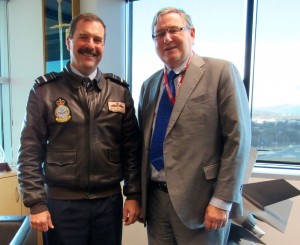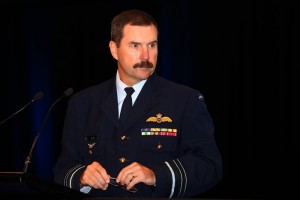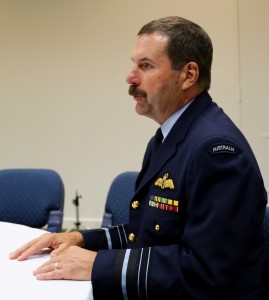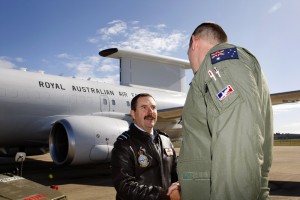2016-04-01 By Robbin Laird
During my March 2016 visit to Australia to attend the Airpower Conference on Multi-Domain Integration and the Williams Foundation Seminar on New Approaches to Air-Land Integration, I had a chance to meet with Air Marshal Davies throughout those sessions and then to meet at his office on March 21, 2016 to do a proper interview.
One of those sessions involved an interaction with the Australian media, where the Air Marshal drove home a core point about the South China Sea and the Australian position with regard to Chinese activities in the area.
Interestingly, the Air Marshal highlighted that the presence of the regional air bosses at the Airpower conference provided an opportunity to discuss mutual concerns and responses.
Clearly, there was an interest on Australia’s part to understand the perceptions of the various regional players and how they might respond.
But the Australian response was clear both at the government level and from the Air Marshal.
The Australian government underscores the importance of rule based behavior in the area, obviously having in mind the Chinese trying to make up their own rules.
And the Air Marshal said that the focus was ensuring that we could do for the next fifty years what we have done for the last in terms of transit and “gateway continuity.”
During my visit in August 2015, I first had the opportunity to interview the COS of the RAAF shortly after he became head of the RAAF.
During that interview, his focus was upon the Middle East operations and ensuring that the Plan Jericho transformation approach launched by his predecessor, Air Marshal Geoff Brown, was gaining traction and momentum.
Question: What has been the impact of the operations in the Middle East on the RAAF?
Air Marshal Davies; We certainly have deployed fighters and air lifters in exercises and operations.

Air Marshal Leo Davies with Robbin Laird after the Second Line of Defense interview at the Air Marshal’s office in Canberra, Australia, August 3, 2015.
But this is the first time we have taken an integrated air package to an operation. It is the first operational experience for both the KC-30A and the Wedgetail and the first time the Super Hornets operated (outside of Red Flag) with F-22s……
Question: There is a general lack of focus on the impact of software upgradeability on force structure modernization to come,
Your Plan Jericho approach fits very well a software upgradeability approach to modernization. Which platforms should be upgraded? And with what software code rewrites to do which tasks?
Air Marshal Davies: This point is generally missed, I was in London at RUSI a few weeks ago and made a similar point. And I got more up and down head movements than I did side to side. And I think there are folk who are beginning to understand this.
But sometimes folk like me are part of the problem. What the leadership I believe needs to do now is just open up the aperture a little bit. And let folk from industry and from defense and I think there’s a really important piece here about what does army, what does navy, and in the United States case, what do the marines, and the coast guard do. What are these folk thinking are options to try and explore, including leveraging the data stream from the F-35.
If we do not open the aperture and change the thought processes, we will be flying the F-35 as if it is a classic four-ship formation fighter and totally miss the point.
It is about culture change.
And the evolution we are discussing will clearly affect coalitions and who we work with.
What I would contend has been unacceptable in the future is coalition partners who don’t know what the coalition partners are flying with and what their ability to contribute is.
Air Marshal Davies opened the two day RAAF Airpower Conference where more than 1,000 attendees from Australia, and the region, the US and Europe participated.
The first day was highlighted by the Minister of Defence and the Service Chiefs providing their perspectives on the challenges and ways ahead for the Australian Defence Force (ADF).
In his opening remarks, Davies highlighted that the RAAF Plan Jericho was dovetailing with similar plans of the other two services.
But because the RAAF was in the throes of a significant modernization and with the coming of the F-35, Plan Jericho was a lead element.
According to the RAAF chief, “Plan Jericho is designed to transform the RAAF into a fifth generation enabled force. This is not a singular airpower effort.” It is multi-domain and cross-cutting with the other services.

During the second day of the Airpower Conference, the focus was upon providing an update on Plan Jericho and progress in the RAAF with regard to the approach and to shaping thinking about multi-domain integration.
The Chief of Staff focused on the increasing demands being placed on RAAF personnel to deal with the challenges of change, and the pace of operations, as well as the coming into the fleet of new capabilities along with newly combat tested assets, such as Wedgetail and the KC-30A.
“The technology maybe cutting edge, but the people in the front lines, and those that create and sustain the effort are those who shape the combat capability.”
Air Marshal Davies Presentation to Airpower Conference, March 16, 2016.
He followed this presentation the next day with the keynote address to the Williams Foundation seminar on new approaches to air-land integration.
He argued throughout his presentation that RAAF transformation was a key driver for the opportunity for shaping a more effective integrated and joint force but it would not happen by itself and required work across the ADF to ensure that transformation would occur.
When we met at his office on March 21, the theme of the intersection between the RAAF and joint innovation was a key focus of the discussion. But what Davies argued was that this is a very dynamic and interactive and open-ended process.
“It is like a jig saw puzzle.
You have these really nice pieces to the puzzle sitting in the container, but until you begin to look at the picture your trying to create through the overall puzzle, you do not know which bit goes where.”
With regard to F-35 as an example, Davies argued the following:
“I think Joint Strike Fighter on its own, a fifth generation air combat aircraft, could be regarded as just an air combat aircraft.
If you want to shoot the bad guy down, if you want to defend the battle space for a land maneuver or for a maritime strike, that’s fine.
But what we’re beginning to appreciate now is that it’s not just an air combat asset it is also an ISR node.
If you were to then put two more pieces of your puzzle down and go, “Well that’s starting to form a bit of a picture here,” in the center of your puzzle. ”
What else could I do if it was truly an ISR node?
How do I manage that asset differently than if it was just going to shoot down another fighter?”
Although the puzzle analogy suggested an overall approach what he really was focusing on the interaction between the evolving bigger picture, and relooking at what each piece of the puzzle might be able to do in fitting into a new puzzle big picture so to speak.
“How would you operate the air warfare destroyer differently as you add a Wedgetail, a P-8, a Triton or an F-35 to its operational environment?

And conversely, how could the changes in how the destroyer would operate as you evolve systems on it, affect how you operate or modernize the other pieces of the evolving puzzle?”
Plan Jericho is about opening the aperture on thinking both about the pieces and the various puzzle pictures, which can be created.
Davis saw two key drivers for change as well in terms of the younger members of the RAAF would rethink how the RAAF could integrate more effectively and industry partners helping inform the RAAF about the art of the possible.
This clearly affects thinking about platforms.
The shift from a platform centric world is not about platforms not mattering; they do; but what is crucial is now evaluating how a new platform contributes in a multi-mission, or multi-tasking and specialized effect for the evolving force.
The government as well as the services working more effectively to shape how their particular new platform contributes to both the service’s core missions as well as the effects desired for the extended battlespace.
Air Marshal Davies argued that when buying platforms going forward, a key consideration beyond their basic functional contribution or task to determining how “integratable” those platforms might be going forward.
“I know it’s a little unfair, but we would probably rethink the combat system on Tiger if we were to buy an armed reconnaissance helicopter tomorrow. Having flown the airplane, I don’t have any issue with the airplane that is Tiger. But how do you integrate it? At the moment it is less than ideal in terms of integration.”
He argued that it was crucial to have a realistic and broad view with regard to force design in mind as one thinks about adding platforms, and a large portion of that force design needs to revolve around “integratability.”
“For example, we are having a long conversation inside Air Force around how would you use a KC-30 better than we currently do?
Well you would integrate it.
So what does that mean for tanker?
It means that we spend a long time in the airspace providing fuel to aircraft. What’s it doing in between the refuels?
It’s flying racetracks or patterns or getting to the next place that gas is needed airborne. What’s it doing while it’s doing that? Why can’t it collect some form of ISR data to be turned to knowledge?

The legacy perspective would be to say: “No it’s an in mid-air refueler and a transport aircraft.”
The new perspective is to think about how the KC-30 can become a communications node for platforms and systems other than fighters. Perhaps you’re able to relay information to soldiers on the ground, or with regard to the new amphibious task force, perhaps you might, from a couple hundred miles off the coast, be able to relay information during the time the tanker is on station.
That makes a lot of sense to me, and a lot of it can happen without the crew having to do one extra bit of work other than provide the node.”
Clearly, as the RAAF brings the F-35 into service it views its value as an asset which it wants to wring as much “integrability” as they can from the “flying combat system.”
“I view the F-35 as a key catalyst of change not just for the Air Force but the entire ADF.
But to get there, we need to focus on our ability to work with the ADF and remain connected.
We can explore; we can provide options.
We can provide core functions for the evolution of the ADF, but we have to make sure that we are able to stay connected, and paced properly.”
And the regional side of the ADF operations was increasingly critical as well for the RAAF.
“This is not just about an Australia/US or just about an Australia/UK connected effort.
This is about being able to work with partners in the region such as we are doing with Fiji on HADR. We need to be able to still do all of those pieces.”
In short, one needed to focus upon “integrability” as the platforms interactively evolved and the missions adapted to threats and technologies.


